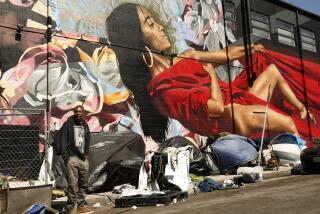Op-Ed: Most of us could do more to make it a truly charitable-giving season
With the charitable-giving season in full swing, and nonprofits in the throes of their end-of-year asks, it feels like the right time to highlight a Scrooge-like fact: Greater Los Angeles is not as generous as it used to be and not as generous as it could be.
A report on individual charitable giving released this fall by the Center for Civil Society at the UCLA Luskin School of Public Affairs showed that charitable giving in Los Angeles County is 12% lower than it was in 2006, the year before the Great Recession hit. Across the county, residents reported cumulative charitable deductions on their 2012 federal tax returns of about $6 billion, which is more or less in line with national averages for urban areas.
Although 40% of area residents reported giving to charity, that means 60% did not. Among those who donated, the average portion of household income given was about 2%.
Surprisingly, where people live was a predictor for how much they gave. In mapping giving in Los Angeles, center researchers found that giving exceeded the average only among two vastly different income groups — the very wealthy, who receive sizable tax deductions for their largesse, and low-income African Americans, who have strong ties to charitable causes through their churches.
Another interesting predictor was immigration. In Los Angeles County, naturalized citizens were more likely to make contributions than their U.S.-born counterparts. And once they had lived in the U.S. for 20 years, immigrants were just as likely to give to charity as the U.S.-born population.
But for most of us who don’t fall within these population groups, our neighborhoods are underperforming when it comes to charitable giving. From Malibu to the Palos Verdes peninsula, across the San Fernando Valley and out through the eastern reaches of the county, a majority of residents are not even among the “2% givers.”
Previous research has shown that many of us who fall somewhere between wealthy and poor honestly think we give more than we actually do. We purchase raffle tickets and holiday wrapping to support local schools and donate to our alma maters. We respond impulsively to individual Internet crowd-funding pleas on behalf of sick children or the fight against Ebola. And we open our wallets when our friends ask us to support a cause. Still, most of us fall short of the 2% mark.
But what about “hidden giving” that isn’t declared on tax forms, such as cash given to extended families, sick friends and relatives, remittances to families out of the country, holiday tips? We don’t know how much or little this is, because survey respondents were asked simply whether they “donated money, assets or property worth more than $25 to charitable or religious organizations.”
However we give, it is a good time to remember the appeal of the gentleman solicitors to Mr. Scrooge: “A few of us are endeavoring to raise a fund to buy the poor some meat and drink and means of warmth. We choose this time because it is a time, of all others, when Want is keenly felt, and Abundance rejoices. What shall I put you down for?”
The center’s previous research on the nonprofit sector showed that the strength of our healthy safety net depends significantly on private donations to supplement government assistance. The same holds true for a vast array of organizations that include those who contribute to the quality of our cultural life, protect the environment or keep our schools going in the wake of a dramatic decline in funding for education.
As the end-of-year charity appeals pick up, it’s important to remember what a difference just a little more giving can make. Nonprofit organizations are under increasing pressure to raise more money through individual donations, especially the many smaller ones that almost invisibly serve high-poverty neighborhoods.
The average annual household deduction of Los Angeles County residents who itemize for charitable gifts currently hovers around $1,400. If that rose just $500 per household, the additional money given to charities, causes and culture would exceed $2 billion. That doesn’t even account for the nongivers or the many households that can afford to give more. In our study, the highest level of generosity occurred in the most wealthy and, in many ways, the least wealthy neighborhoods. May most of the rest of the Los Angeles region hear an echo of “A Christmas Carol”: “What shall I put you down for?”
Bill Parent is director of the Center for Civil Society at the UCLA Luskin School of Public Affairs. He is co-author with Paul Ong, Silvia Jimenez and Elena Ong of “The State of Donations: Individual Charitable Giving in Los Angeles,” which was funded by the Annenberg Foundation.Follow the Opinion section on Twitter @latimesopinion
More to Read
A cure for the common opinion
Get thought-provoking perspectives with our weekly newsletter.
You may occasionally receive promotional content from the Los Angeles Times.






